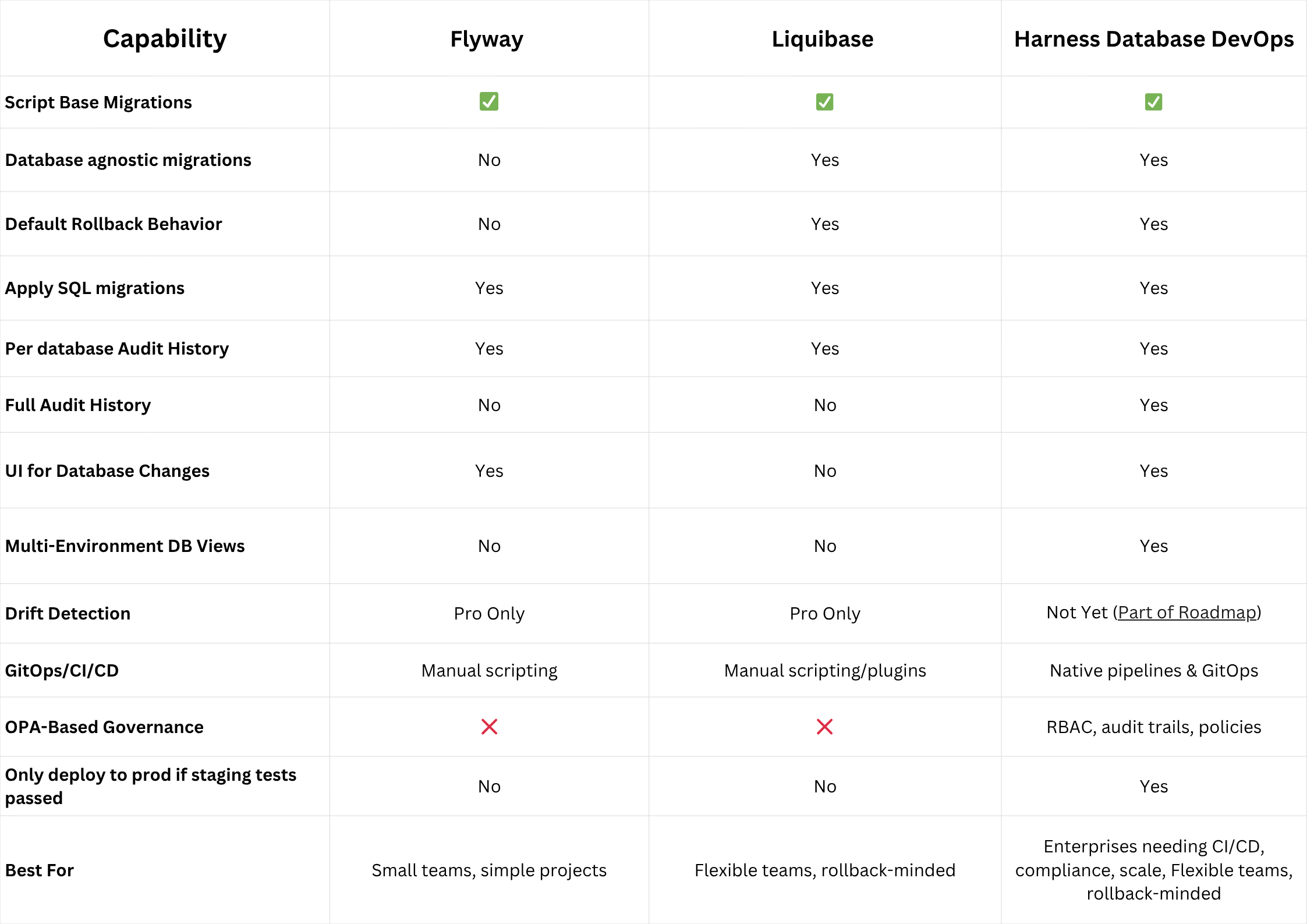
Database DevOps has risen in importance as organisations look to bring the same automation and governance found in application pipelines to their data layer. Removing the overhead of manually managing SQL scripts and schema changes is an interesting challenge that has produced a wide variety of tools.
Many products in the market offer similar solutions, and choosing the right one, whether it’s Flyway, Liquibase, or Harness Database DevOps, can significantly impact workflows and the productivity of both developers and DBAs.
Why Choosing the Right Tool Matters?
When it comes to database DevOps tools, requirements vary widely depending on whether you are an individual developer, a growing startup, or a regulated enterprise. This is why each tool is marketed with specific purposes in mind. Understanding these positioning differences helps you make an informed decision about which solution fits your particular needs.
What is Flyway?
Flyway is one of the simplest and most popular migration frameworks, widely known for its lightweight, script-based approach. Changes are managed through sequential SQL files that are version-controlled and applied in order, making it easy to adopt for small teams or projects where speed matters more than governance.
Flyway has seen a strong adoption among organisations which use Microsoft SQL Server. This is due in part to joint marketing efforts with Microsoft, which has made Flyway a natural fit in SQL Server-centric environments.
The Pro edition of Flyway extends beyond script-based migrations by introducing state-based migrations. However, this approach comes with trade-offs. State-based migrations attempt to reconcile the database schema against a desired end state, auto-generating the SQL to get there. While this simplifies certain workflows, it also has add-on risks such as non-deterministic SQL generation, unintended data loss, and limited control in complex production environments. For this reason, state-based migrations are generally not recommended for production use in most organizations.
What is Liquibase?
Liquibase takes a more flexible approach than Flyway by allowing schema changes to be defined not only in SQL but also in XML, YAML, or JSON. This hybrid model is often cited as an advantage, since it can provide rollback behavior out-of-the-box and make it easier to standardize changes across multiple database types with minor SQL differences.
That said, the rollback capability depends heavily on the type of changeset being used. For DSL-based changesets (YAML, XML, JSON), Liquibase can auto-generate rollback logic for roughly 80% of scenarios. However, when using raw SQL changesets, rollback logic must still be explicitly provided, similar in Flyway. This creates an extra burden on teams which depends heavily on SQL, and can limit the perceived “automatic rollback” advantage.
The Pro edition extends Liquibase’s capabilities with drift detection, policy checks, and richer reporting features. These additions make it more suitable for enterprises that require better visibility and governance. Liquibase’s strength lies in its rollback functionality and vibrant community ecosystem, but verbose DSLs and the need for backward logic can slow down developer velocity, especially in organisations that want faster, more automated workflows.
What is Harness Database DevOps?
Harness Database DevOps is a modern Database DevOps platform designed to bring the same automation, governance, and scalability that organizations already expect in application delivery pipelines. Unlike Flyway or Liquibase, which began as migration frameworks, Harness was purpose-built for enterprises that want to fully automate database delivery in alignment with CI/CD and GitOps practices.
What set’s Database DevOps apart is its usage of harness’s cross-module, best in class CI/CD pipeline. Database changes can flow through the same workflows as application code, with built-in support for approvals, RBAC, audit trails, and policy enforcement. Multi-environment orchestration and GitOps-native workflows are supported out of the box, making it possible to manage schema changes at scale with consistency and compliance. Unlike the other solutions, Harness delivers a strongly opinionated, enterprise-grade solution that goes beyond migrations and into full database governance, best practices, and automation.
In addition to orchestrating and running database migrations, Harness Database DevOps provides features for improving the developer experience around these database changes. This includes visibility into what changes are deployed where, when, and what they did. It also includes industry first AI capabilities to design and author database schema migrations from scratch, while leveraging built-in database best practices.
Harness is best suited for enterprises that want automated CI/CD for their database, want to reduce manual overhead, benefit from baked-in best practices, and enforce compliance without slowing down development teams.
Key Differences

Conclusion
Database change management has evolved beyond simply applying migrations. Today, the priority is to ensure schema changes are delivered with the same level of reliability, automation, and governance as application code. Flyway delivers speed and simplicity for small teams. Liquibase offers rollback safety and drift detection for teams that can handle its manual overhead. Harness Database DevOps goes further by embedding governance, automation, and GitOps directly into the CI/CD pipeline, making it the most compelling option for enterprises that need to scale database delivery confidently.
👉 If your organization is ready to move beyond migration frameworks and Harness Database DevOps is the natural next step.
FAQ
1. What’s the difference between Flyway and Liquibase?
Flyway focuses on simplicity with forward-only SQL migrations, making it ideal for small teams. Liquibase is more flexible, with rollback support and multiple DSLs.
2. Why choose Harness over Liquibase Pro or Flyway Enterprise?
Liquibase Pro and Flyway Enterprise extend their OSS tools with enterprise features, but they still rely heavily on manual setup and scripting. Harness, by contrast, was designed as a CI/CD-first platform that embeds governance, rollback automation, and GitOps directly into database delivery pipelines.
In addition, Harness offers two differentiators that go beyond traditional migration frameworks:
- Visibility: Rich insights into what changes were deployed, when, where, and their impact across environments, enabling faster troubleshooting and compliance reporting.
- LLM-powered authoring: Industry-first AI assistance to help developers and non-DBAs design and generate schema migrations aligned with best practices, reducing errors and accelerating delivery.

